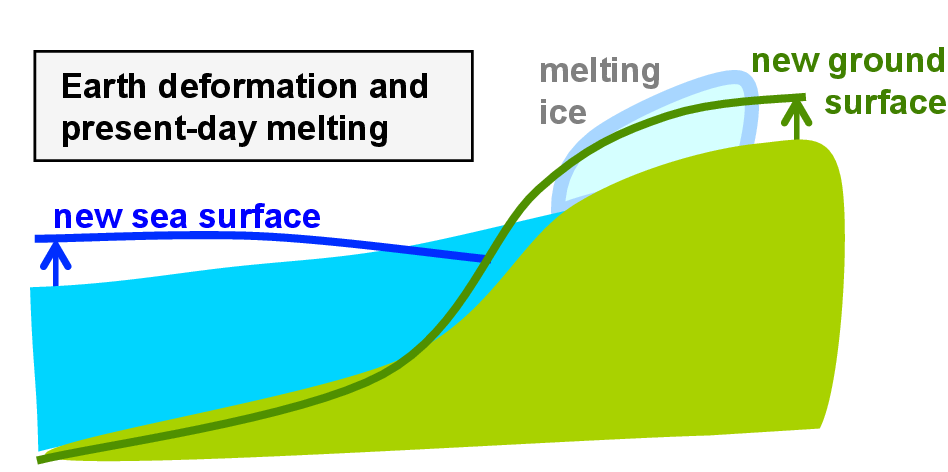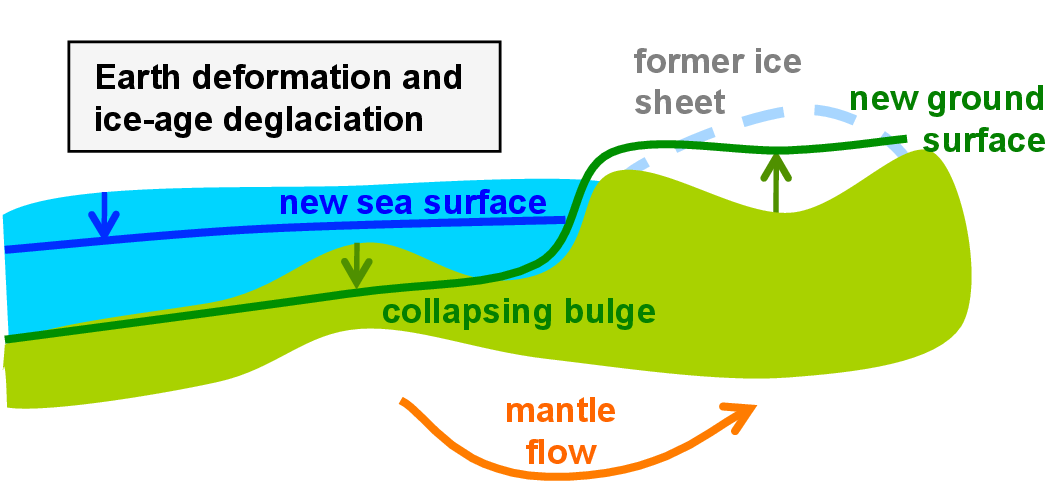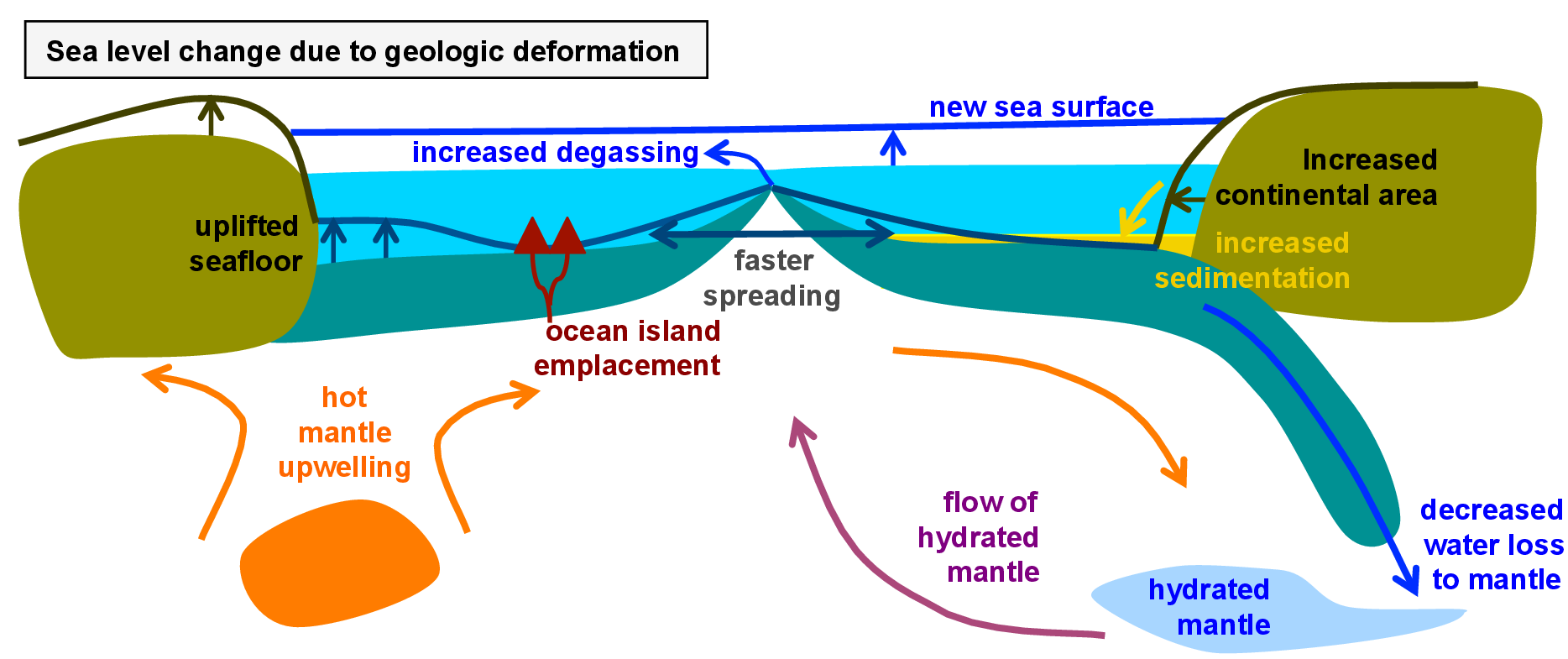- Conrad, C.P. (2013), The solid earth's influence on sea
level, Geological Society of America Bulletin,
125, 1027-1052, doi:10.1130/B30764.1.
[online version]
[reprint]
[cover image]
Elastic Deformation: Important for Modern Sea Level Change
 On the shortest timescales, redistributions of water loads on the
Earth's surface (e.g., glacial melting) cause elastic
deformation of the Earth, which affects sea level. This
mechanism causes sea level to rise more slowly in regions
close to rapid mass loss, and faster away from
them. Future climate change-induced sea level rise will be dramatically
influenced by this type of solid earth deformation.
On the shortest timescales, redistributions of water loads on the
Earth's surface (e.g., glacial melting) cause elastic
deformation of the Earth, which affects sea level. This
mechanism causes sea level to rise more slowly in regions
close to rapid mass loss, and faster away from
them. Future climate change-induced sea level rise will be dramatically
influenced by this type of solid earth deformation.
- Veit†, E., and C.P. Conrad (2016), The impact of groundwater depletion on spatial variations in sea level change during the past century,
Geophysical Research Letters, 43, 3351-3359, doi:10.1029/2012GL068118.
[online version]
[reprint]
[sea level response model]
- Fiedler§, J.W., and
C.P. Conrad (2010), Spatial variability
of sea level rise due to water impoundment behind
dams, Geophysical Research Letters, 37, L12603, doi:10.1029/2010GL043462.
[online version]
[reprint]
[highlight in Nature]
[response model]
- Conrad, C.P., and B.H. Hager (1997), Spatial variations in the rate of sea level rise
caused by the present-day melting of glaciers and ice sheets,
Geophysical Research Letters, 24, 1503-1506, doi:10.1029/97GL01338.
[online version]
[reprint]
- Conrad, C.P., and B.H. Hager (1995), The elastic response of the earth to interannual
variations in Antarctic precipitation, Geophysical
Research Letters, 22, 3183-3186, doi:10.1029/95GL03176.
[online version]
[reprint]
Viscous Deformation: Glacial Isostatic Adjustment (GIA)
 On timescales of thousands to hundreds of thousands of years, the
solid earth responds to surface loading by slow
deformation as the mantle viscously deforms. This
deformation can produce dramatic changes in sea level as
both the land surface and the sea surface deform. Indeed, these
surfaces are still adjusting to deglaciation that ended after
the last ice age (glacial isostatic adjustment or GIA).
However, the patterns and amplitudes of deformation are
difficult to estimate because Earth's interior
structures are heterogeneous. We have developed ways to
characterize the viscosity structures within the Earth
and to estimate the GIA deformation that results from them.
On timescales of thousands to hundreds of thousands of years, the
solid earth responds to surface loading by slow
deformation as the mantle viscously deforms. This
deformation can produce dramatic changes in sea level as
both the land surface and the sea surface deform. Indeed, these
surfaces are still adjusting to deglaciation that ended after
the last ice age (glacial isostatic adjustment or GIA).
However, the patterns and amplitudes of deformation are
difficult to estimate because Earth's interior
structures are heterogeneous. We have developed ways to
characterize the viscosity structures within the Earth
and to estimate the GIA deformation that results from them.
-
Weerdesteijn†, M.F.M., and C.P. Conrad (2024), Recent ice melt above a mantle plume track is accelerating the uplift of Southeast Greenland,
Communications Earth & Environment, 5, 791, doi:10.1038/s43247-024-01968-6.
[online]
[reprint]
[supplement]
[review]
-
Weerdesteijn†, M.F.M., J.B. Naliboff,
C.P. Conrad, J.M. Reusen, R. Steffen, T. Heister, and
J. Zhang (2023), Modeling viscoelastic
solid earth deformation due to ice age and contemporary
glacial mass changes in ASPECT, Geochemistry,
Geophysics, Geosystems, 24, e2022GC010813, doi:10.1029/2022GC010813.
[online version]
[reprint]
-
Weerdesteijn†, M.F.M.,
C.P. Conrad, and J.B. Naliboff (2022), Solid earth uplift due to contemporary ice melt above low-viscosity regions of the upper mantle,
Geophysical Research Letters, 49, e2022GL099731, doi10.1029/2022GL099731.
[online version]
[reprint]
[supplement]
-
Hartmann†, R., J. Ebbing, and C.P. Conrad (2020), A Multiple 1D Earth Approach (M1DEA) to account for lateral viscosity variations in solutions of the sea level equation: An application for glacial isostatic adjustment by Antarctic deglaciation,
Journal of Geodynamics, 135, 101695, doi:10.1016/j.jog.2020.101695.
[online version]
[reprint]
[GitHub: Rotational Feedback for Selen]
Geological Deformation: Sea Level Through
Earth History
 On timescales longer than millions of years, geological deformations
largely control sea level change. These mostly occur via
mechanisms that change the volume of the ocean basins,
such as changes in seafloor spreading, sedimentation
cover, seafloor volcanism, dynamic deflection of the
seafloor, and net contraction or expansion of continental
area. Seawater may also be lost to the mantle interior via
subduction, or outgassed by volcanism, and imbalances
between these processes can lead to sea level change.
On timescales longer than millions of years, geological deformations
largely control sea level change. These mostly occur via
mechanisms that change the volume of the ocean basins,
such as changes in seafloor spreading, sedimentation
cover, seafloor volcanism, dynamic deflection of the
seafloor, and net contraction or expansion of continental
area. Seawater may also be lost to the mantle interior via
subduction, or outgassed by volcanism, and imbalances
between these processes can lead to sea level change.
-
Karlsen†, K.S., M. Domeier, C. Gaina, and C.P. Conrad (2020), A tracer-based algorithm for automatic generation of seafloor age grids from plate tectonic reconstructions,
Computers and Geosciences, 140, 104508, doi:10.1016/j.cageo.2020.104508.
[online version]
[preprint]
[supplemental material]
[TracTec code]
-
Sames, B., M. Wagreich, C.P. Conrad, and S. Iqbal (2020) Aquifer-eustasy as the main driver of
short-term sea-level fluctuations during Cretaceous hothouse
climate phases,
Geological Society, London, Special Publications,
498, 9-38, doi:10.1144/SP498-2019-105.
[online version]
[reprint]
-
Karlsen†, K.S., C.P. Conrad,
and V. Magni (2019), Deep water cycling and sea level change since the breakup of Pangea,
Geochemistry, Geophysics, Geosystems, 20, 2919-2935, doi:10.1029/2019GC008232.
[online version]
[reprint]
-
Plyusnina, E.E., D.A. Ruban, C.P. Conrad, G.d.S. dos Anjos Zerfass, and H. Zerfass (2016), Long-term eustatic cyclicity in the Paleogene: a critical assessment, Proceedings of the Geologists' Association, 127, 425-434, doi: 10.1016/j.pgeola.2016.03.006.
[online version]
[reprint]
- Sames, B., M. Wagreich, J.E. Wendler,
B.U. Haq, C.P. Conrad, M.C. Melinte-Dobrinescu,
X. Hu, I. Wendler, E. Wolfgring, I.Ö. Yilmaz, and
S.O. Zorina (2016), Review: Short-term sea-level changes in
a greenhouse world - a view from the Cretaceous,
Palaeogeography, Palaeoclimatology, Palaeoecology,
441, Part 3, 393-411, doi:10.1016/j.palaeo.2015.10.045.
[online version]
[Cretaceous Sea Level Volume]
[reprint]
- Ruban, D.A., and C.P. Conrad (2013), Late Silurian-Middle Devonian long-term
shoreline shifts on the northern Gondwanan margin: Eustatic
versus tectonic controls, Proceedings of the
Geologists' Association, 124, 883-892, doi:10.1016/j.pgeola.2012.12.004.
[online version]
[reprint]
- Ruban, D.A., S.O. Zorina, C.P. Conrad, and
N.I. Afanasieva (2012), In quest of Paleocene
global-scale transgressions and regressions: constraints
from a synthesis of regional trends, Proceedings
of the Geologists' Association, 123, 7-18, doi:10.1016/j.pgeola.2011.08.003.
[online version]
[reprint]
- Ruban, D., C.P. Conrad, and A.J. van Loon
(2010), The challenge of reconstructing
the Phanerozoic sea level and the Pacific Basin
tectonics, Geologos, 16, 237-245, doi:10.2478/v10118-010-0007-9.
[online version]
[reprint]
- Ruban, D., S. Zorina, and C.P. Conrad (2010),
No global-scale transgressive-regressive
cycles in the Thanetian (Paleocene): evidence from
interregional correlation, Palaeogeography
Palaeoclimatology Palaeoecology, 295, 226-235, doi:10.1016/j.palaeo.2010.05.040.
[online version]
[reprint]
- Conrad, C.P., and L. Husson (2009), Influence of dynamic topography on sea level
and its rate of change, Lithosphere, 1,
110-120, doi:10.1130/L32.1.
[online version]
[reprint]
[dynamic topography model]
- Husson, L., and C.P. Conrad (2006), Tectonic velocities, dynamic topography, and relative sea level, Geophysical Research Letters, 33, L18303, doi:10.1029/2006GL026834.
[online version]
[reprint]
- Xu, X., C. Lithgow-Bertelloni, and C.P. Conrad
(2006), Global reconstructions of Cenozoic
seafloor ages: Implications for bathymetry and sea level,
Earth and Planetary Science Letters, 243, 552-564, doi:10.1016/j.epsl.2006.01.010.
[online version]
[reprint]
|



